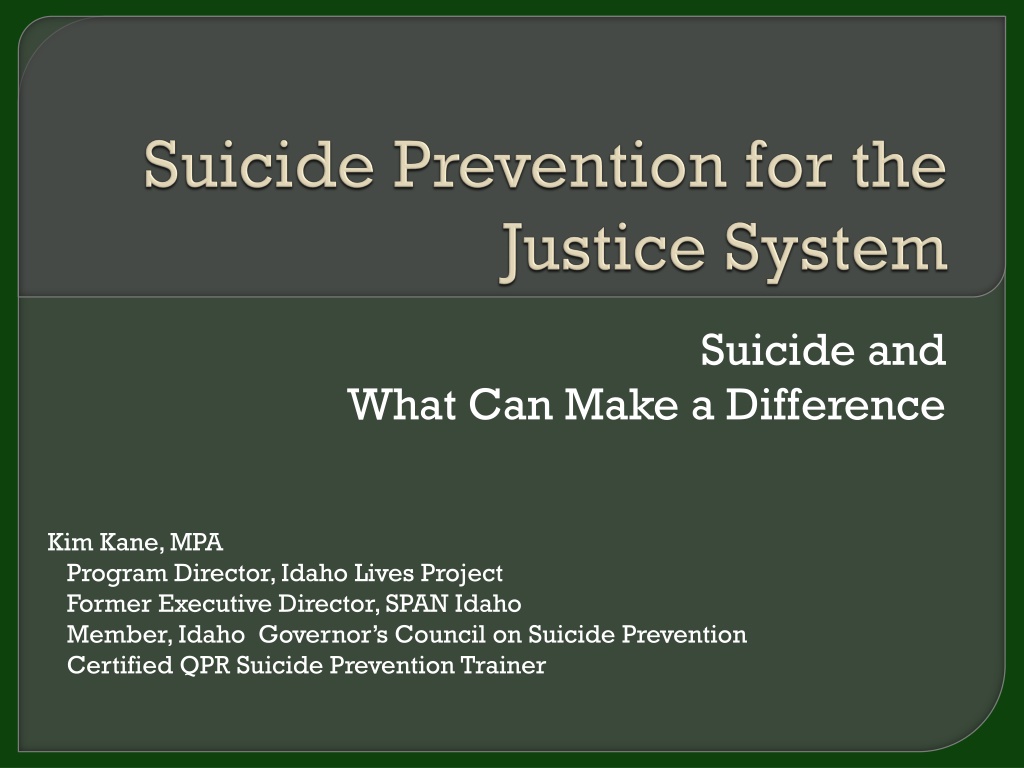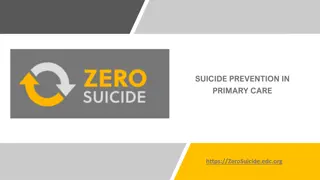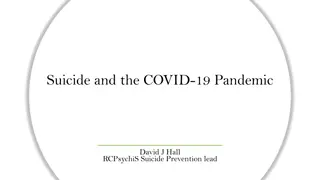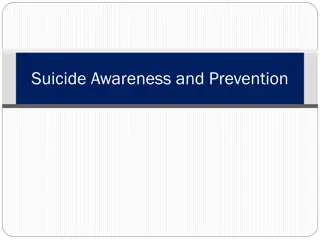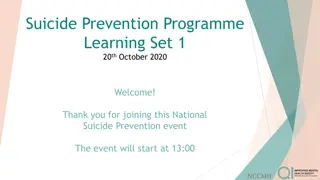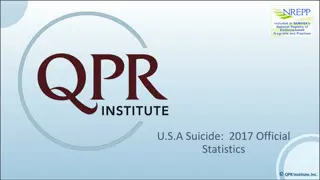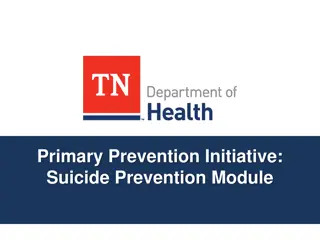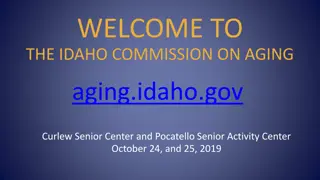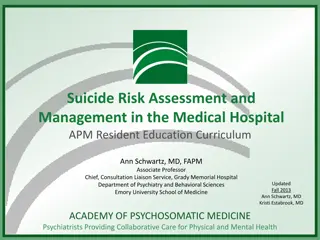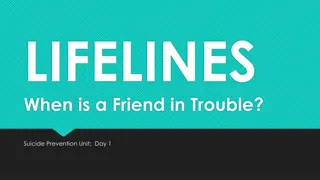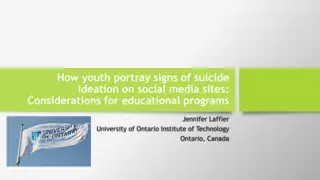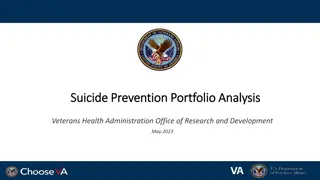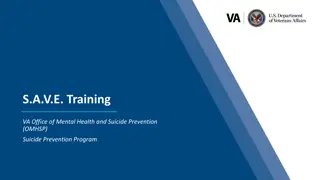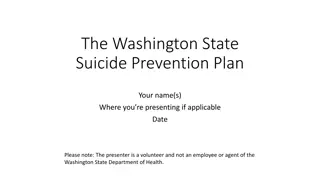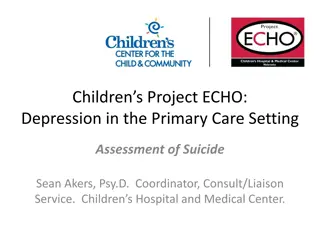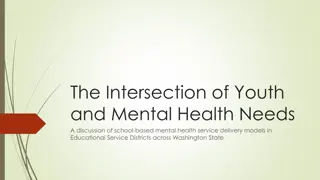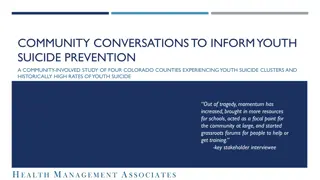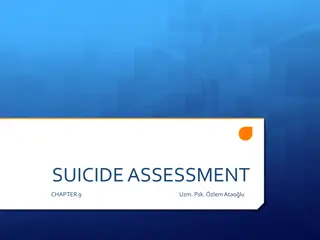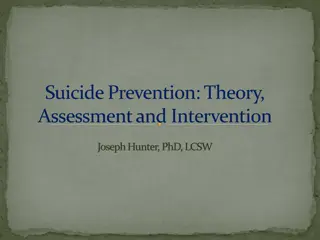Understanding Suicide Prevention Efforts in Idaho
Explore the impactful work of Kim Kane, MPA, and the Idaho Lives Project in suicide prevention. Gain insights into the statistics, challenges, and regional efforts aimed at reducing suicide rates in Idaho. Discover the valuable resources provided by SPAN Idaho to support individuals in crisis and promote mental well-being.
Download Presentation

Please find below an Image/Link to download the presentation.
The content on the website is provided AS IS for your information and personal use only. It may not be sold, licensed, or shared on other websites without obtaining consent from the author. Download presentation by click this link. If you encounter any issues during the download, it is possible that the publisher has removed the file from their server.
E N D
Presentation Transcript
Suicide and What Can Make a Difference Kim Kane, MPA Program Director, Idaho Lives Project Former Executive Director, SPAN Idaho Member, Idaho Governor s Council on Suicide Prevention Certified QPR Suicide Prevention Trainer
SPAN IDAHO WHY? STATS SAVE A LIFE CLINICAL PREVENTION SURVIVOR SUPPORT FACILITIES
A 501(c)(3) non-profit Vision : Idahoans choose to live A Resource www.spanidaho.org 208-860-1703
BOARD OF DIRECTORS 13 Volunteers STAFF Executive Director Resource Specialist REGIONAL CHAPTERS 8 Chapters Volunteer chairperson(s) Volunteer participants www.spanidaho.org 8 8 Driggs Driggs (new) (new)
US 2011 ID 2011 ID 2012 ID 2013 Total Deaths 39,518 24 299 308 Deaths/week 760 5.5 6 6 Suicide Rate 12.7 17.9 18.7 19.1
Sun. Mon. Tues. Wed. Thurs. Fri. Sat. 1 2 3 4 5 X X X X 6 7 8 9 10 11 12 X X X X X X 13 14 15 16 17 18 19 X X X X X X 20 21 22 23 24 25 26 X X X X X 27 28 29 30 31 X X X X X
23.3 17.9 12.7 6.0 15 24 9 U.S. D.C. Wyoming Idaho
We are not unlike our neighbors Top Eleven States, 2011 Wyoming Oklahoma Arizona Colorado 1. 1. Montana 3. New Mexico 4. Alaska 5. Vermont 6. Nevada 7. 8. 9. 9. Utah 11. Idaho
We are not unlike our neighbors Top Eleven States: 1. Wyoming 2. Alaska 3. Montana 4. Nevada 5. New Mexico 6. Idaho 7. Oregon 8. Colorado 9. South Dakota 10. Utah 11. Arizona
Lack of Access Easy Access Boot straps Stigma/Rugged individualist culture
2ndleading cause of death among Idahos youth. 29% Idaho Teen (age 14-19) Mortality Idaho Bureau of Vitial Records and Health Statistics, 2010 1% 8% 3% Accidents 3% Suicide 3% Cerebrovacular 5% Malignancies 48% Heart diseases Congenative Malform Pneumonitis 29% Other
Idaho high school students, 2013 YRBS shows 1 in 7 have considered suicide 1 in 13 have attempted suicide 1 in 8 actually have a suicide plan
Idaho has lost 83 school-aged children to suicide in the last 5 years. (2008-20012) 16 of those children were age 14 or younger
Suicide is the leading cause of death in American jails. Suicide rates in prison are higher than the general population, but higher still are rate in smaller facilities Suicide rates in local jails are 4 - 9x than the national rate.
Those who enact murder-suicide, including school shooters are first suicidal. Suicide is primary; murder is secondary. To understand the primary source code of violence the suicidal mind we must first understand that persistent suicidal thoughts and feelings are markers of unremitting, unendurable psychological pain and suffering. ~ Paul Quinnett, PhD
Distinguished Research Professor and The Bright-Burton Professor in the Department of Psychology at Florida State University Author of over 400 peer-reviewed publications Editor-in-Chief of the journal Suicide & Life-Threatening Behavior Author of Why People Die by Suicide, Myths About Suicide and Lonely at the Top.
Why People Die by Suicide Those Who Desire Suicide Those Who Are Capable of Suicide D i s t a l F a c t o r s Perceived Burdensomeness Fearlessness about Pain, Injury & Death Acquired Ability for Self-Harm Thwarted Belongingness Serious Attempt or Death by Suicide Derived from Sketch of a Theory Power Point presentation, 2013 Thomas Joiner, PhD
Suicide: Fact vs. Fiction
1.Asking someone about suicide might plant the seed or increase risk. 2.More females attempt suicide than males. 3.Suicides increase over the winter holidays. 4.Very young children complete suicide. 5.Most suicidal people are ambivalent about it. 6.Suicide is often done on whim, especially among youth. 7.Restricting access to lethal means is a critical prevention method.
People routinely survive deep depression and suicidal thoughts and behaviors. The basic instinct to survive is ever-present. Suicidal people survive because someone identifies what s happening and gets help. 90% of those who complete suicide had a mental health or substance about disorder. THESE DISORDERS ARE TREATABLE!
SUICIDE IS COMPLEX Mental Illness Substance Abuse Family History Lack of Support Abuse Previous Attempt Hopelessness
Suicide is multi-facetted There is never just one thing that leads to suicide There can, however, be a triggering event: Arrest itself Fear of transfer to more secure facility or undesirable placement Failure in the program Suicide of a peer/contagion Threat of/failure to visit Death in the family Loss of relationship Ridicule from peers
90% of those who die by suicide had a mental health and/or substance use disorder. 55%-75% of those in jail or prison have a mental health disorder, including depression. Three quarters of those have a co-occurring substance use disorder. What does this tell us about the potential for prevention?
Unhelpful Suicide is inevitable Suicide is selfish S/He only wants attention Threats and attempts are two of the most significant precipitating factors for suicide Labeling suicidal thoughts Such labels increase stigma or behavior as irrational or and can cause youth to shut crazy down/not seek out or accept help Suicide is preventable Suicidal youth irrationally believe they are a burden Helpful
The more signs, the greater the risk. R I S K 1. 2. 3. 4. 5. 6. Warning signs are especially important if the person has attempted suicide in the past. One sign alone may not indicate suicidality butall signs are reason for concern and several signs may indicate suicidality, and any one of three signs alone is cause for immediate action.
Previous suicide attempts Talking about, making a plan or threatening to complete suicide Isolation, withdrawal from friends, family or society Agitation, especially when combined with sleeplessness Nightmares
Ive decided to kill myself. I wish I were dead. I m going to commit suicide. I m going to end it all. If _______ doesn t happen, I ll kill myself. QPR Institute
Im tired of life; I just cant go on. My family would be better off without me Who cares if I m dead anyway. I just want out. Pretty soon you won t have to worry about me. QPR Institute
Changed eating habits or sleeping patterns Giving away prized possessions, making final arrangements, putting affairs in order Themes of death or depression in conversation, writing, reading or art Recent loss of a friend or family member through death, suicide or divorce Sudden dramatic decline or improvement in the program
Feeling hopeless or trapped Use or increased use of drugs and/or alcohol Chronic headaches and stomach aches, fatigue Major mood swings or abrupt personality changes Neglect of personal appearance Taking unnecessary risks or acting reckless No longer interested in favorite activities or hobbies.
Room Confinement Withdrawal from Alcohol or Drugs Court or other Legal Hearing Significant Date to the Offender Receipt of Bad News Impending Release/Transfer Family Threat of/Failure to Visit Failure/Lack of Progress in the Program Ridicule from Peers Severe Guilt or Shame about Offense Sexual/Physical Assault
Talking about wanting to die or to kill oneself Looking for a way to kill oneself Talking about feeling hopeless or having no reason to live
Any suspicion that the person may be suicidal must be acted upon. Any report of such suspicions by the person s family or other inmates (if incarcerated) should also be taken seriously.
Yes, some may use the threat of suicide or a feigned suicide attempt to manipulate the system or get attention. Attention-getting tells us something. Challenging to tell the difference Attempt habituation can lead to underestimation of lethality. TAKE ALL THREATS SERIOUSLY
Connect with the person Avoid discussing personal info that may be embarrassing in front of others Reduce stress of the unknown Monitor emotions before and after visitation or calls Assist the person in managing conflict Encourage discussion and role play re: court or PO visit, etc.
Can be challenging be persistent Talk in semi-private location if possible Avoid trying to identify with the person Avoid trying to argue him/her out of it Understand, listen and refer Try to understand how the person may see him/herself: Rigid thinking, overgeneralizing, catastrophizing, attachment, trauma
Listening is Powerful! Explore suicidality level of intent Listen non-judgmentally Use reflective listening Reasons for dying Refrain from offering advice/solutions or interrupting with your experience Reasons for living Offer hope, support, willingness to help/get help
Get a commitment to accept help and make arrangements and contact family/friends Ensure person is not left alone Notify family If person is deemed to be at high risk, also contact mental health agency where the person can go for further help. 1-800-273-TALK (8255) Call police if person is in possession of a weapon Follow up with person/family and mental health agency Debrief staff involved self care Document everything!
Not about curing mental illness Reduce stigma associated with mental health problems Reduce stigma associated with help-seeking Being in treatment and using crisis services Remove barriers to getting help Building Hope Symptom reduction Identity change Resolving hopelessness Relationships that last Finding a life worth living From M. David Rudd, PhD
Suicidality is fluid On the bridge, Baldwin counted to ten and stayed frozen. He counted to ten again, then vaulted over. I still see my hands coming off the railing, he said. As he crossed the chord in flight, Baldwin recalls, I instantly realized that everything in my life that I d thought was unfixable was totally fixable except for having just jumped. Tad Friend. Jumpers. The New Yorker (2003)
Willingness to act (motivation to die) People talk about reasons for dying Preparation to act (preparation and rehearsal behaviors) People prepare for their death Will, letters, finances, research Capability to act Builds over time with exposure Ordinarily people engage in the behavior for some time prior to death High Risk Behavior Self-mutilation Suicide Attempts Barriers to act (reasons for living) People will discuss their ambivalence about death Relationships critical From M. David Rudd
The role of shame and guilt Influence on the assessment dynamic Recognize the fluid nature of intent Identify and reinforce individual ambivalence Reasons for dying are readily accessible to those in crisis Reasons for living are often unrecognized and inaccessible From M. David Rudd, PhD
Impulsivity 33 2001 Data 21 20 % 13 6 0-17 18-24 25-44 45-64 65+ Age group N=1,671 CT, ME, UT, WI, Allegheny County, San Francisco County
Hospital Discharge THE warning sign Capability Loss of connectedness Burdensomeness Shame/Embarrassment Non-Compliance with treatment ~37% of suicides are by those in treatment Represents persistence of hopelessness and intent Issue of personal responsibility for care Potential implicit messages Treatment doesn t work Treatment is hopeless From M. David Rudd, PhD
